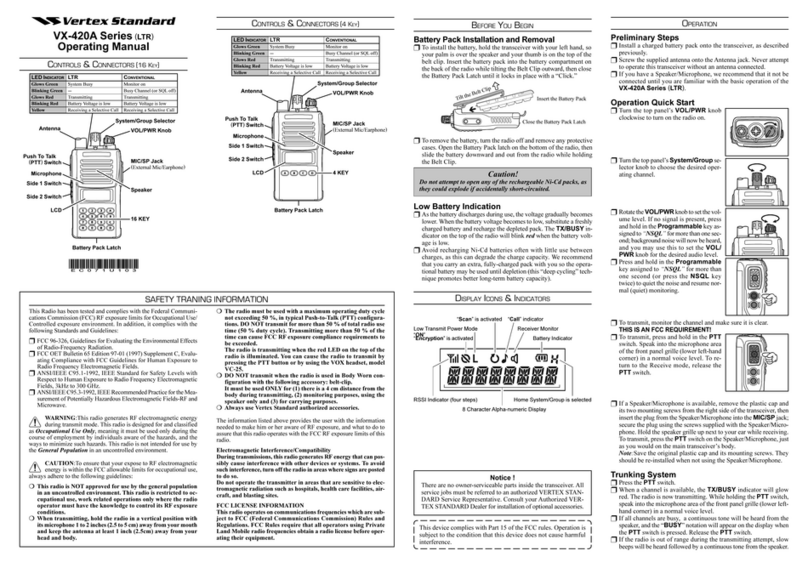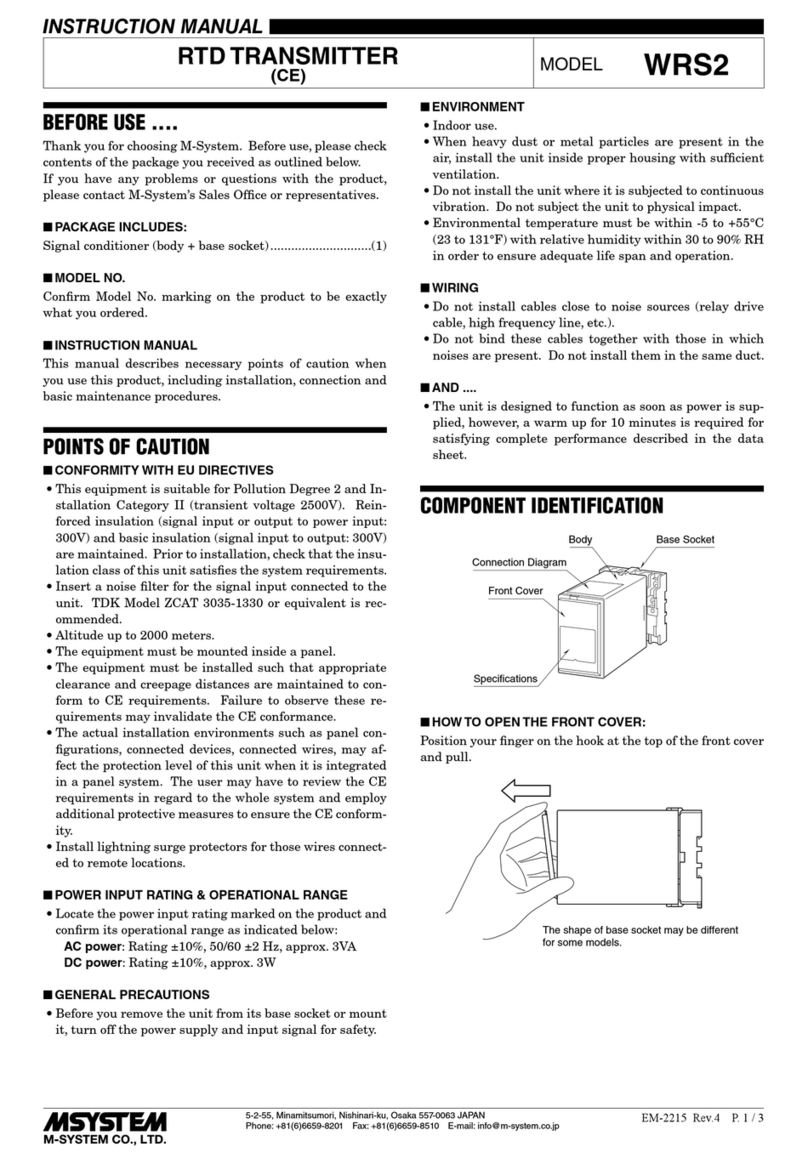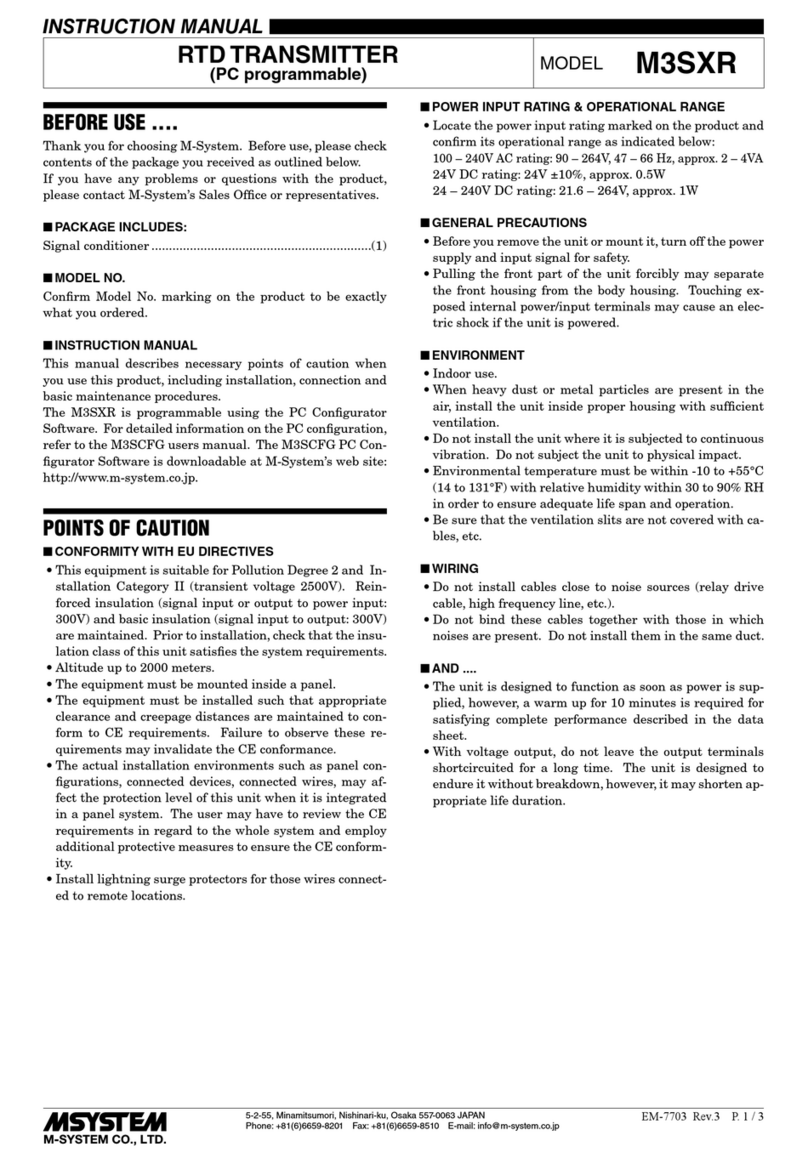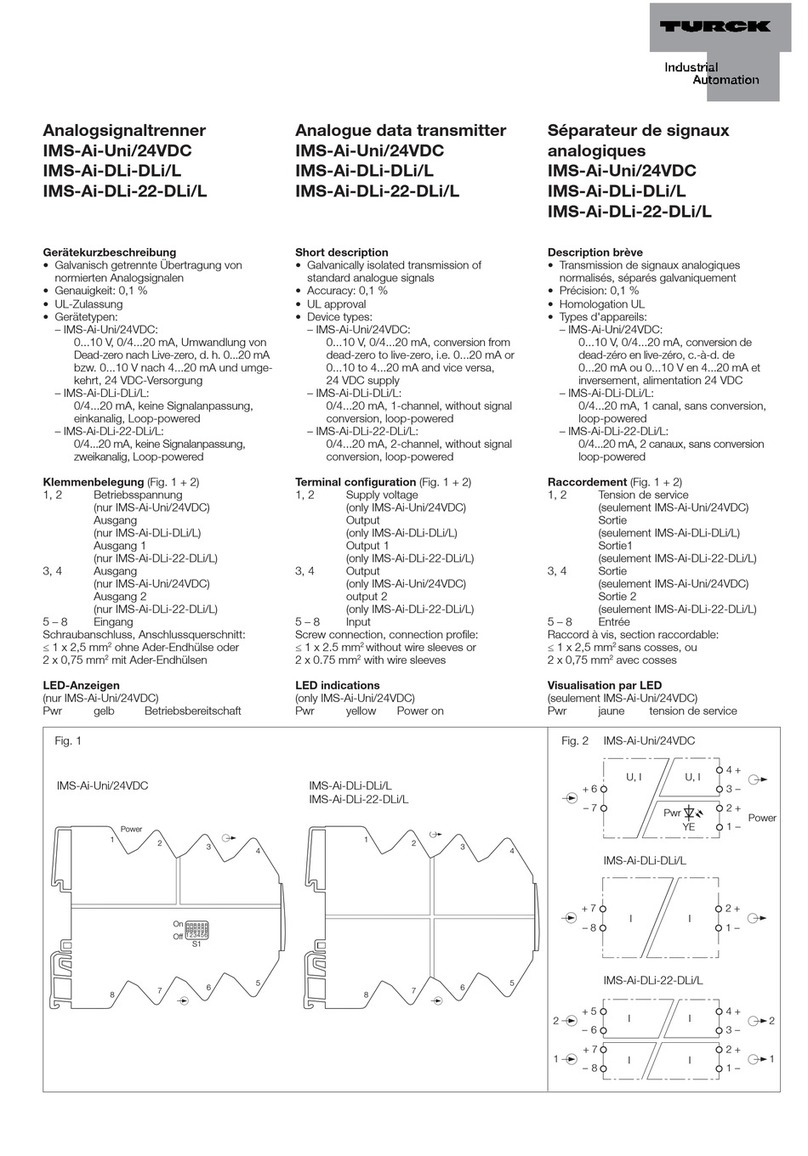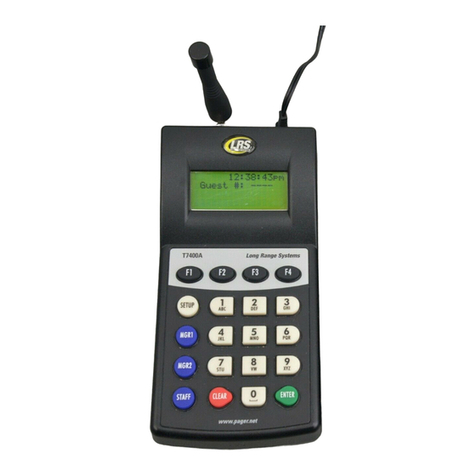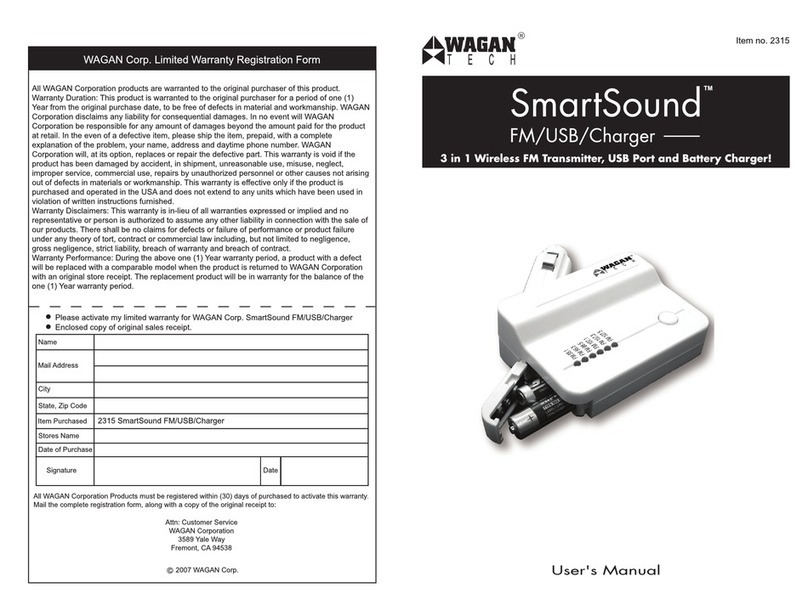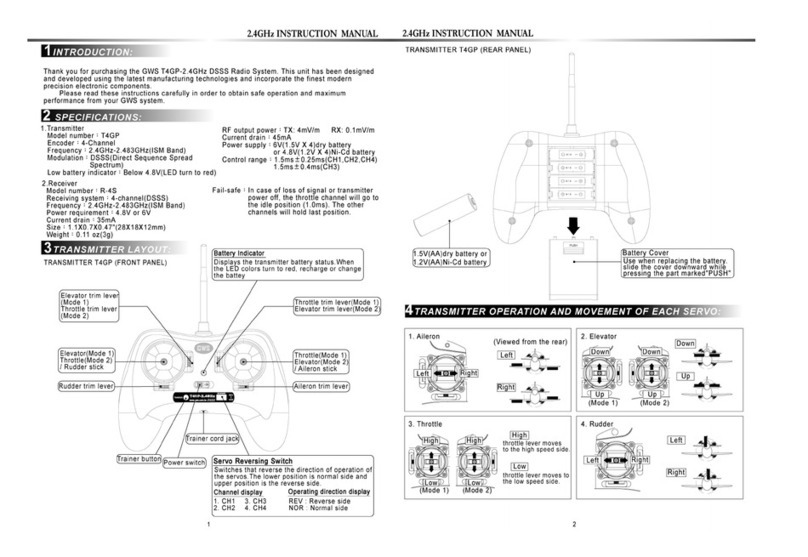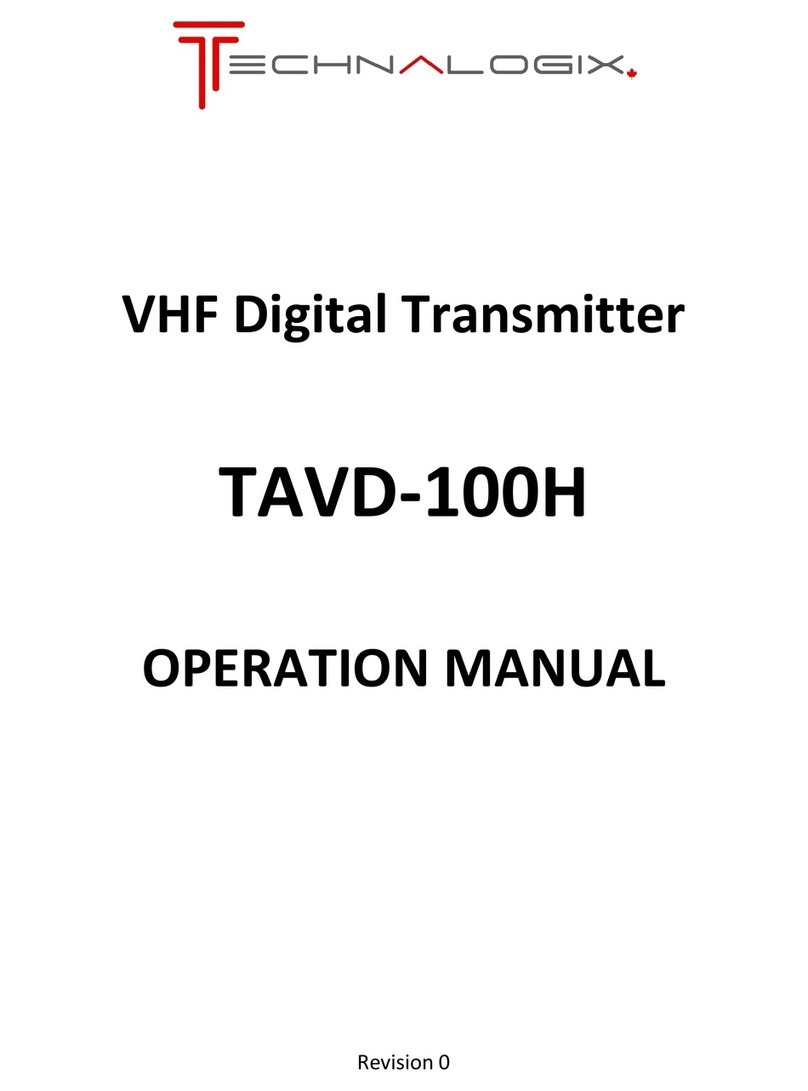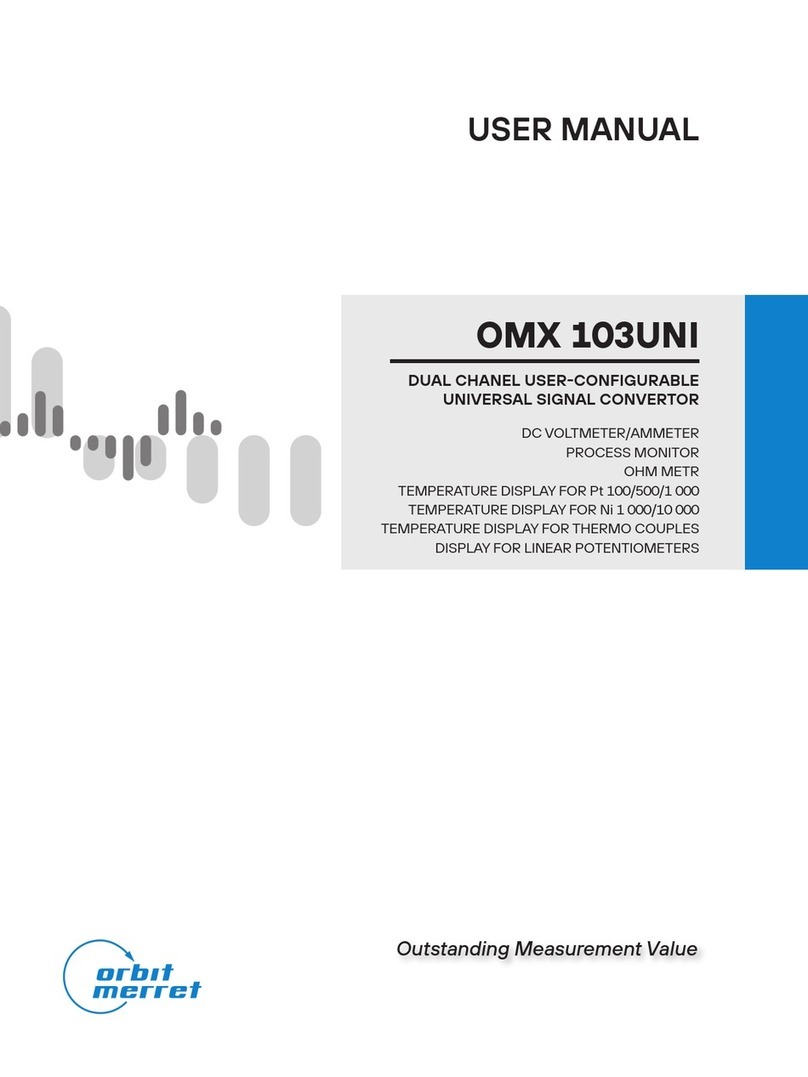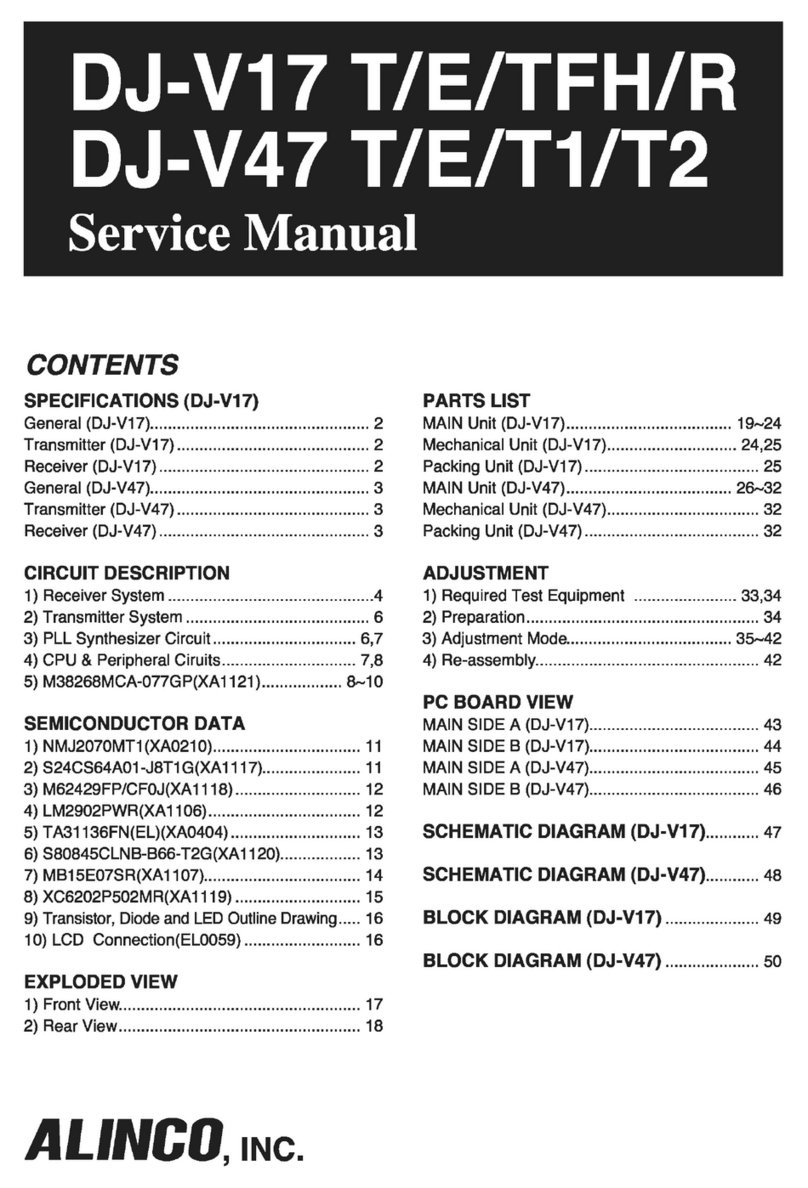Vertex Standard VX-820E Series User manual

ABC D
A321
B654
C987
D0
16-Key Version 4-Key Version Non-LCD Version
VX-820E S
ERIES
OPERATING MANUAL
Vertex Standard LMR, Inc.

Warning! FCC RF Exposure Requirements ................ 2
Controls & Connectors (16-Key Version) .................... 4
Controls & Connectors (4-Key Version) ...................... 5
Controls & Connectors (Non-LCD Version) ............... 6
LCD Icons & Indicators (16-Key & 4-Key Versions) . 7
Before You Begin ........................................................... 8
Battery Pack Installation and Removal ...................... 8
Low Battery Indication .............................................. 8
Operation........................................................................ 9
Preliminary Steps ....................................................... 9
Operation Quick Start ................................................ 9
Automatic Time-Out Timer ...................................... 11
Advanced Operation ................................................... 12
Programmable Key and Toggle Switch Functions ... 12
Descriptipon of Operating Functions ....................... 14
ARTS (Auto Range Transpond System) .................... 22
DTMF Paging System.................................................. 22
User Set Mode (16-Key & 4-Key Versions) ............... 23
Optional Accessories .................................................... 24
CONTENTS
Disposal of your Electronic and
Electric Equipment
Products with the symbol (crossed-out wheeled bin)
cannot be disposed as household waste.
Electronic and Electric Equipment should be recycled
at a facility capable of handling these items and their
waste byproducts.
In EU countries, please contact your local
equipment supplier representative or service
center for information about the waste col-
lection system in your country.

VX-820E SERIES OPERATING MANUAL
1
ATTENTION IN CASE OF USE
This transceiver works on frequencies which are not generally permitted.
For frequency allocation, apply for a licence at your local spectrum manage-
ment authority.
For actual usage contact your dealer or sales shop in order to get your trans-
ceiver adjusted to the allocated frequency range.
Congratulations!
You now have at your fingertips a valuable communications tool-a VERTEX STANDARD two-way radio!
Rugged, reliable and easy to use, your VERTEX STANDARD radio will keep you in constant touch with
your colleagues for years to come, with negligible maintenance down-time. Please take a few minutes to
read this manual carefully. The information presented here will allow you to derive maximum performance
from your radio, in case questions arise later on.
We’re glad you joined the VERTEX STANDARD team. Call on us anytime, because communications is
our business. Let us help you get your message across.
Notice!: There are no owner-serviceable parts inside the radio. All service jobs must be referred to an
authorized VERTEX STANDARD Service Representative. Consult your Authorized VERTEX STANDARD
Dealer for installation of optional accessories.
List of the practicable area
AUT BEL CYP CZE DNK
EST FIN FRA DEU GRC
HUN ISL IRL ITA LVL
LIE LTU LUX MLT NLD
NOR POL PRT SVK SVN
ESP SWE CHE GBR ---

VX-820E SERIES OPERATING MANUAL
2
WARNING! RF EXPOSURE REQUIREMENTS
This Radio has been tested and complies with the 1999/519/EC RF exposure limits. In addition, it complies
with the following Standards and Guidelines:
ANSI/IEEE C95.1-1992, IEEE Standard for Safety Levels with Respect to Human Exposure to Radio Fre-
quency Electromagnetic Fields, 3 kHz to 300 GHz.
ANSI/IEEE C95.3-1992, IEEE Recommended Practice for the Measurement of Potentially Hazardous Elec-
tromagnetic Fields - RF and Microwave.
WARNING:
This radio generates RF electromagnetic energy during transmit mode. This radio is designed for and
classified as Occupational Use Only, meaning it must be used only during the course of employment by
individuals aware of the hazards, and the ways to minimize such hazards. This radio is not intended for
use by the General Population in an uncontrolled environment.
This radio is NOT approved for use by the general population in an uncontrolled exposure environ-
ment. This radio is restricted to occupational use, work related operations only where the radio op-
erator must have the knowledge to control his or her RF exposure conditions.
When transmitting, hold the radio in a vertical position with its microphone 2 inches (5 cm) away
from your mouth and keep the antenna at least 2 inches (5 cm) away from your head and body.
The radio must be used with a maximum operating duty cycle not exceeding 50%, in typical Push-to-
Talk configurations.
DO NOT transmit for more than 50% of total radio use time (50% duty cycle). Transmitting more
than 50% of the time can cause RF exposure compliance requirements to be exceeded.
The radio is transmitting when the red LED on the top of the radio is illuminated. You can cause the
radio to transmit by pressing the P-T-T button.
SAR compliance for body-worn use was only demonstrated for the specific belt-clip Part Number
(#RA060190A). Other body-worn accessories or configurations may NOT comply with the RF expo-

VX-820E SERIES OPERATING MANUAL
3
sure requirements and should be avoided.
DO NOT transmit when the radio is used in Body Worn configuration with the following accessory:
belt-clip.
It must be used ONLY for (1) there is 4 cm distance from the body during transmitting, (2) monitor-
ing purposes, using the speaker only and (3) for carrying purposes.
Always use Vertex Standard authorized accessories.
The information listed above provides the user with the information needed to make him or her
aware of RF exposure, and what to do to assure that this radio operates with the RF exposure limits of
this radio.
Electromagnetic Interference/Compatibility
During transmissions, this radio generates RF energy that can possibly cause interference with
other devices or systems. To avoid such interference, turn off the radio in areas where signs are
posted to do so.
Do not operate the transmitter in areas that are sensitive to electromagnetic radiation such as hospi-
tals, health care facilities, aircraft, and blasting sites.
WARNING! RF EXPOSURE REQUIREMENTS

VX-820E SERIES OPERATING MANUAL
4
CONTROLS & CONNECTORS (16-KEY VERSION)
PTT Switch
MONITOR Button
LAMP Button
MIC/SP Jack
(External MIC/SP)
Battery Pack LatchLCD (Liquid Crystal Display)
Speaker
Microphone
LED Indicator
Steady Red:
Transmitting in progress
Blinking Green:
Busy Channel
Steady Green:
Tone Squelch in defeated condition
Dealer Programmed Color:
Emergency, 5-Tone Decoded, or
2-Tone Decoded
16-Button DTMF Keypad
Antenna Jack
TOP SEL Key
CH (Channel)Selector
VOL/PWR Knob
: one of “Flashing in white,”
“Continuation changes in
sequential colors,” or “tog-
gling the two colors.”

VX-820E SERIES OPERATING MANUAL
5
ABC D
CONTROLS & CONNECTORS (4-KEY VERSION)
PTT Switch
MONITOR Button
LAMP Button
MIC/SP Jack
(External MIC/SP)
Battery Pack LatchLCD (Liquid Crystal Display)
Speaker
Microphone
LED Indicator
Steady Red:
Transmitting in progress
Blinking Green:
Busy Channel
Steady Green:
Tone Squelch in defeated condition
Dealer Programmed Color:
Emergency, 5-Tone Decoded, or
2-Tone Decoded
4-Button Programmable Key
Antenna Jack
TOP SEL Key
CH (Channel)Selector
VOL/PWR Knob
: one of “Flashing in white,”
“Continuation changes in
sequential colors,” or “tog-
gling the two colors.”

VX-820E SERIES OPERATING MANUAL
6
CONTROLS & CONNECTORS (NON-LCD VERSION)
PTT Switch
MONITOR Button
LAMP Button
MIC/SP Jack
(External MIC/SP)
Battery Pack Latch
Speaker
Microphone
LED Indicator
Steady Red:
Transmitting in progress
Blinking Green:
Busy Channel
Steady Green:
Tone Squelch in defeated condition
Dealer Programmed Color:
Emergency, 5-Tone Decoded, or
2-Tone Decoded
Antenna Jack
TOP SEL Key
CH (Channel)Selector
VOL/PWR Knob
: one of “Flashing in white,”
“Continuation changes in
sequential colors,” or “tog-
gling the two colors.”

VX-820E SERIES OPERATING MANUAL
7
LCD ICONS & INDICATORS (16-KEY & 4-KEY VERSIONS)
12 Character Alpha-numeric Display
SUB-LCD
888: Channel Group Number
-P-: Priority Channel
-H-: Home Channel
In: ARTS “In Range”
Out: ARTS “Out of Range”
RSSI Indicator (four steps)
Encryption is activated
Option SW (Key Func-
tion) is activated
Low Transmit Power Mode On
“DUAL WATCH” is activated
This channel on “SCAN” List
Priority Scan is activated
“CALL” Indicator Receiver Monitor
“Talk-Around” is enabled
“Voice Message” is received
Battery Indicator
“Group Scan” is enabled

VX-820E SERIES OPERATING MANUAL
8
BEFORE YOU BEGIN
Battery Pack Installation and Removal
To install the battery, hold the transceiver with
your left hand, so your palm is over the speaker
and your thumb is on the top of the belt clip. Care-
fully mate the battery’s four insertion slots with
their corresponding alignment tabs on the trans-
ceiver case, while tilting the Belt Clip outward.
Proper alignment occurs with the battery pack
offset about 1/2 inch from the top edge of the bat-
tery compartment.
Guide the pack on to the tabs with a slight inward
pressure, then slide the battery pack upward, un-
til it locks in place with a “Click.”
To remove the battery, turn the radio off and re-
move any protective cases. Slide the Battery Pack
Latch on the bottom of the radio toward the front
panel while sliding the battery down about 1/2
inch. Then lift the battery out from the radio while
unfolding the Belt Clip.
Do not attempt to open any of the recharge-
able Lithium-Ion packs, as they could ex-
plode if accidentally short-circuited.
Low Battery Indication
As the battery discharges during use, the voltage
gradually becomes lower. When the battery voltage
becomes to low, substitute a freshly charged battery
and recharge the depleted pack. The LED indicator
on the top of the radio will blink red when the bat-
tery voltage is low.
Caution
Danger of explosion if battery is replaced with
an incorrect battery. Replace only with the same
or equivalent type.
Tilt the Belt Clip
Insert the Battery Pack

VX-820E SERIES OPERATING MANUAL
9
OPERATION
Preliminary Steps
Install a charged battery
pack onto the transceiver, as
described previously.
Screw the supplied antenna
onto the Antenna jack.
Never attempt to operate this
transceiver without an an-
tenna connected.
If you have a Speaker/Mi-
crophone, we recommend that it not be connected
until you are familiar with the basic operation of
the VX-820E.
Operation Quick Start
Turn the top panel’s
VOL/PWR knob clock-
wise to turn the radio on.
Turn the top panel’s CH
selector knob to choose
the desired operating
channel. On the 16-key
and 4-key versions, a
channel name will appear
on the LCD.
If you want to select the operating channel from
a different Memory Channel Group, press the Pro-
grammable key (assigned to the Memory Group
Up or Down function) to select the Memory Chan-
nel Group you want before selecting the operat-
ing channel. A Group name will appear on the
LCD whenever the Programmable key is pressed.
Note: Some models are programmed so that the
operating channels are selected by the Program-
mable key and the memory channel group is se-
lected by the CH selector knob. For further de-
tails, contact your VERTEX STANDARD dealer.

VX-820E SERIES OPERATING MANUAL
10
Rotate the VOL/PWR
knob to set the volume
level. If no signal is
present, press and hold in
the MONITOR button
(under the PTT switch)
more than 2 seconds;
background noise will
now be heard, and you
may use this to set the
VOL/PWR knob for the
desired audio level. Press
and hold the MONITOR
button more than 2 seconds (or press the MONI-
TOR button twice) to quiet the noise and resume
normal (quiet) monitoring.
To transmit, monitor the
channel and make sure it
is clear.
Press and hold the PTT
switch. Speak into the mi-
crophone area of the front
panel grille (above the upper left edge of the LCD)
in a normal voice level. To return to the Receive
mode, release the PTT switch.
Press the (Orange) TOP
SEL key to activate one
of the preprogrammed
functions which may
have been enabled at the
time of programming by
the dealer. See the next section for details regard-
ing the available features.
If a Speaker/Microphone is available, remove the
plastic cap and its two mounting screws from the
right side of the transceiver, then align the con-
nector of the Speaker/Microphone on the trans-
ceiver body; secure the connector pin using the
screws supplied with the Speaker/Microphone.
Hold the speaker grille up next to your ear while
receiving. To transmit, press the PTT switch on
the Speaker/Microphone, just as you would on
the main transceiver’s body, and speak into the
microphone on a normal voice level.
Note 1): Save the original plastic cap and its
mounting screws. They should be reinstalled
when not using the Speaker/Microphone.
2) When you press the PTT switch on the
Speaker/Microphone, it disables the internal mi-
crophone, and vice versa.
OPERATION

VX-820E SERIES OPERATING MANUAL
11
If the Busy Channel Lockout feature has been
programmed on a channel, the radio will not trans-
mit when a carrier is present. Instead, the radio
will generate short beep three times and indicate
“*ERROR *” on the display (16-key and 4-key
versions). Release the PTT switch and wait for
the channel to be clear of activity.
If CTCSS or Digital Coded Squelch (DCS) Lock-
out has been programmed on a channel, the radio
can transmit only when there is no carrier being
received or when the carrier being received in-
cludes the correct CTCSS tone or DCS code.
Automatic Time-Out Timer
If the selected channel has been programmed for
automatic time-out, you must limit the length of each
transmission. While transmitting, a beep will sound
10 seconds before time-out. Another beep will sound
just before the deadline; the “TX” indicator will dis-
appear and transmission will cease soon thereafter.
To resume transmitting, you must release the PTT
switch and wait for the “penalty timer” to expire.
OPERATION

VX-820E SERIES OPERATING MANUAL
12
ADVANCED OPERATION
Programmable Key Functions
All versions of the VX-820E include the TOP SEL,
SIDE SEL, MONITOR, and LAMP keys, and the
TOGGLE switch. The 16-key and 4-key versions
include the [A], [B], [C], and [D]function keys. Fur-
thermore, the 16-key version includes the []and
[#]function keys. The Programmable key functions
can be customized, via programming by your VER-
TEX STANDARD dealer, to meet your communica-
tions/network requirements. Some features may re-
quire the purchase and installation of optional inter-
nal accessories. The possible Programmable key pro-
gramming features are illustrated at the right, and
their functions are explained on page 14. For further
details, contact your VERTEX STANDARD dealer.
For future reference, check the box next to each func-
tion that has been assigned to the Programmable key
on your particular radio, and keep it handy.
:Requires FVP-25 or FVP-35 Encryption Unit
TOP SEL
FUNCTION
None
Monitor
Lamp
Scan
Dual Watch
Low Power
Talk Around
TX Save Disable
Encryption
Follow-Me Scan
MONITOR LAMP [A] [B] [C] [D]
PROGRAMMABLE KEY
[] [#]

VX-820E SERIES OPERATING MANUAL
13
ADVANCED OPERATION
FUNCTION
Follow-Me Dual Watch
Group Up
Group Down
Channel Up
Channel Down
Set
Call/Reset
Call 1
Call 2
Call 3
Call 4
Call 5
Code Up
Code Down
Code Set
Speed Dial
Option SW 1
Option SW 2
Emergency
Home
Selectable Tone
Direct Channel #1
Direct Channel #2
Direct Channel #3
Direct Channel #4
REC/PLAY
SQL
AF Min Volume
Status Set
Status Up
Status Down
Status Check
Audio PC (PIT)
Lone Worker
DTMF Code Set
TA Scan
TOP SEL MONITOR LAMP [B] [C] [D]
PROGRAMMABLE KEY
:Requires DVS-5 Voice Storage Unit
[A]/[] [#]

VX-820E SERIES OPERATING MANUAL
14
Description of Operating Functions
MONITOR
Press the assigned programmable key to cancel
CTCSS- and DCS-controlled squelch; the BUSY/
TX indicator will glow green. Press and hold this
button for 1.5 seconds to hear background noise
(unmute the audio); the BUSY/TX indicator will
blink green.
LAMP
Press the assigned programmable key to illuminate
the LCD for five seconds.
SCAN
The Scanning feature is used to monitor multiple sig-
nals programmed into the transceiver. While scan-
ning, the transceiver will check each channel for the
presence of a signal, and will stop on a channel if a
signal is present.
To activate scanning:
Press the assigned programmable key to activate
scanning.
The scanner will search the channels of each chan-
nel, looking for active ones; it will pause each time
it finds a channel on which someone is speaking.
Press the assigned programmable key again to dis-
able scanning. Operation will revert to the pro-
grammed revert channel.
Note: Your dealer may have programmed your ra-
dio to stay on one of the following channels if you
press the PTT switch during scanning pause:
Current channel (“Talk Back”)
“Last Busy” channel
“Priority” channel
“Home” channel
“Scan Start” channel
ADVANCED OPERATION

VX-820E SERIES OPERATING MANUAL
15
DUAL WATCH
The Dual Watch feature is similar to the SCAN fea-
ture, except that only two channels are monitored:
The current operating channel; and
The Priority channel.
To activate Dual Watch:
Press the assigned programmable key.
The scanner will search the two channels; it will
pause each time it finds a channel on which some-
one is speaking.
To stop Dual Watch:
Press the assigned programmable key.
Operation will revert to the “Dual Watch Start”
channel.
LOW POWER
Press the assigned programmable key to set the
radio’s transmitter to the “Low Power” mode, thus
extending battery life. Press the key again to return
to “Normal” transmit power when in difficult ter-
rain.
When the radio’s transmitter is set to “Low Power”
mode, the “ ” icon will be indicated on the dis-
play.
TALK AROUND (TA)
Press the assigned programmable key to activate the
Talk Around feature when you are operating on du-
plex channel systems (separate receive and transmit
frequencies, utilizing a “repeater” station). The Talk
Around feature allows you to bypass the repeater sta-
tion and talk directly to a station that is nearby. This
feature has no effect when you are operating on “sim-
plex” channels, where the receive and transmit fre-
quencies are already the same.
When the “TA” function is activated, the “ ” icon
will be indicated on the display.
Note that your dealer may have mode provision for
“Talk Around” channels by programming “repeater”
and “Talk Around” frequencies on two adjacent chan-
nels. If so, the key may be used for one of the other
Pre-Programmed Functions.
ADVANCED OPERATION

VX-820E SERIES OPERATING MANUAL
16
TX SAVE DISABLE
Press the assigned programmable key to disable the
Transmit Battery Saver, if you are operating in a lo-
cation where high power is almost always needed.
The Transmit Battery Saver helps extend battery life
by reducing transmit power when a very strong sig-
nal from an apparently nearby station is being re-
ceived. Under some circumstances, though, your
hand-held radio may not be heard well at the other
end of the communication path, and high power may
be necessary at all times.
ENCRYPTION (OPTION)
Press the assigned programmable key to toggle the
Encryption feature “On” and “Off.”
AUDIO PC (PIT)
Press the assigned programmable key to toggle the
Audio Pitch Controller “On” and “Off.”
When you turn the Audio Pitch Controller ON, the
receive audio is enhanced in the high-range frequen-
cies.
FOLLOW-MESCAN
The “Follow-Me” Scan feature checks a User-as-
signed Priority Channel regularly as you scan other
channels. Thus, if only Channels 1, 3, and 5 (of the 8
available channels) are designated for “Scanning,”
the user may nonetheless assign Channel 2 as the
“User-assigned” Priority Channel via the “Follow-
Me” feature.
To activate “Follow-Me” scanning, first select the
channel you want to designate as the “User-Assigned
Priority Channel” and press the assigned program-
mable key. Then rotate the CH Selector knob to re-
call to the “Scanning Start” channel which has been
programmed by your dealer to activate the scanner.
When the scanner stops on an “Active” channel, the
User-assigned Priority Channel will automatically be
checked every few seconds; if activity is found on
the User-assigned Priority Channel, the radio will
switch between it and the Dealer-Assigned Priority
Channel, if any.
ADVANCED OPERATION

VX-820E SERIES OPERATING MANUAL
17
FOLLOW-MEDUAL WATCH
To set up a “Dual Watch” frequency pair using the
“Follow-Me” feature, select a channel using the CH
Selector knob. Now press the assigned programmable
key; pressing the assigned programmable key locks
the current channel as the User-assigned Priority
Channel. Now rotate the CH Selector knob to select
another channel (not the “Scanning Start” channel).
Your radio will now switch back-and-forth between
the currently-selected channel and the User-assigned
Priority Channel.
During “Follow-Me” scanning (after you have
pressed the key), you can set up the “Dual Watch”
feature by rotating the CH Selector knob to another
channel. The radio will then scan back and forth be-
tween the original User-assigned Priority Channel
and the newly-selected channel.
The Priority Channel you have assigned (before
pressing the key) will be retained in memory until
you change it.
GROUP UP/DOWN
Press the assigned programmable key to select a dif-
ferent group of channels. Once the desired Group is
reached, rotate the CH Selector knob to select the
desired channel within the selected Group.
You may wish to have the Scanner pass through more
than one Group during the scanning process (nor-
mally, scanning is performed within the current group
only). To include the current Group in the scanning
loop, press and hold in the assigned programmable
key for one second. To remove a Group from Group
Scan, press and hold in the assigned programmable
key again for one second.
Multi-Group Scanning is only possible if you are us-
ing the “User Scan” list. To edit the User Scan list,
press and hold the assigned programmable key for
one second to delete the current Memory Group from
the Scanning. Alternatively, press and hold the as-
signed programmable key for one second to delete
the Current Memory channel from the Scanning.
When you delete a Group or channel, “-SCAN Skip-”
will appear on the LCD for one second after pressing
the assigned programmable key. To restore a particu-
lar channel to your scanning list, press and hold in the
assigned programmable key again for one second;
ADVANCED OPERATION

VX-820E SERIES OPERATING MANUAL
18
“-SCAN Stop-” will appear on the LCD for one sec-
ond after pressing the assigned programmable key.
CHANNEL UP/DOWN
Press the assigned programmable key to select a dif-
ferent channel within the current group.
SET
Press the assigned programmable key to activate the
“User Set” (Menu) Mode. See page 20 for details
CALL/RESET
While the DTMF Paging System
This feature, if enabled, allows the user to change
the 3-digit Page Call code, used to call other simi-
larly-equipped stations. Press the assigned program-
mable key, followed by the three digits representing
the Page Call code of the station you wish to call.
Three tones will be heard after the last key is pressed
(the new code will now be transmitted).
The receiver squelch of the other station will be
opened, and you can begin communication.
While the 2-Tone/5-Tone Paging System
This feature, if enabled, press the assigned program-
mable key to send a 2-tone/5-tone sequential tone.
CALL 1 TO CALL 5
Press the assigned programmable key to send a 2-
tone/5-tone sequential tone group which is pre-de-
fined.
CODE UP/DOWN
Press the assigned programmable key to select a 2-
tone/5-tone encode code from the pre-defined encode
list.
CODE SET
Press the assigned programmable key to change the
encode digits for 5-tone operation. To change a spe-
cific digit, select the desired digit using the [A]key,
then change the number using the [B]/[C]keys, and
store the number using the [D]key.
SPEED DIAL (16-KEY VERSION ONLY)
Your Dealer may have pre-programmed Auto-Dial
telephone number memories into your radio.
To dial a number, press the assigned programmable
key, then press the front panel’s numeric key corre-
sponding to the Auto-Dial memory number list pro-
vided by your Dealer or Network Administrator. The
DTMF tones sent during the dialing sequence will
be heard in the speaker.
ADVANCED OPERATION
Other manuals for VX-820E Series
2
Table of contents
Other Vertex Standard Transmitter manuals
